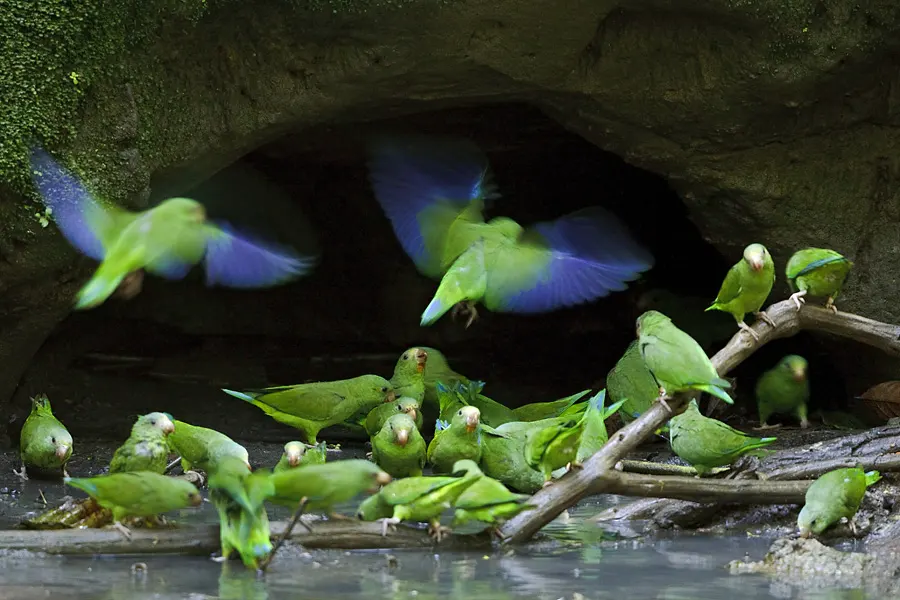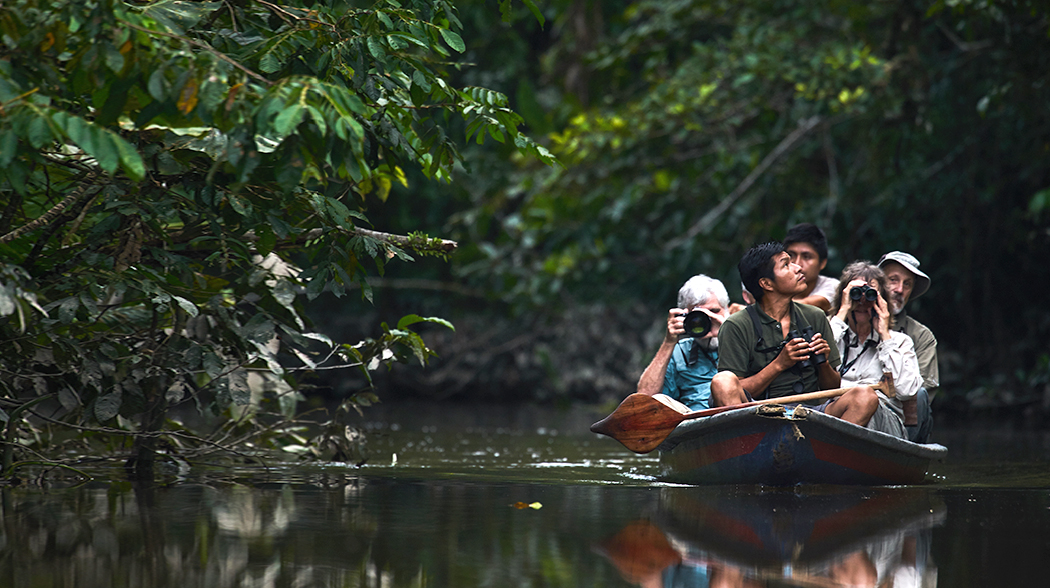- info@sanilodge.com
- + 593 9 6 089 7833
Sanilodge
The most biodiverse spot in the planet per unit hectare. We are the only ecolodge in Ecuador 100% owned and run by an indigenous community
The highest biodiversity in the Ecuadorian Amazon Rainforest!
The most biodiverse spot in the planet per unit hectare. We are the only ecolodge in Ecuador 100% owned and run by an indigenous community
The highest biodiversity
in the Ecuadorian Amazon Rainforest!

Adventure Experience
4 Days
Macaws, Toucans, Parrots, Sloths, Black caimans, Monkeys and a close encounter with the Amazonian flora: millennial Kapok trees, useful palms, orchids, and bromeliads. Parrot clay lick, Ethnomedicine, Amazonian cultures, walks on primary forests with naturalist-bilingual guides, birdwatching at 118 foot canopy tower, canoe rides, piranha fishing, night walks in search of reptiles and amphibians.
Read More
Birding & Photography Tours
4 Days
Guaranteed check list of 180 bird species out of the 565 found so far !. Bird specialties Rufous Potoo, Harpy Eagle ( rare ) black-red neck Cotinga, Cocha Antshrike, local and bilingual bird guides available. Feeders around the lodge for photography, amazing sunsets and sunrises , frogs, snakes, myriad of insects, tame wildlife.
Read More

DEEP Jungle Experience
5 Days
The hidden corners of the Amazon jungle, home of tapirs, giant otters, peccaries. Exquisite flora and fauna, ancient cultures, traditions, ancestral medicine. 6 hour-hike on remote trails , birding and wildlife viewing from the canopy tower, piranha fishing, 12 species of monkeys , parrot clay lick, night canoe rides and walks searching for insects, night mammals and reptiles
Read MorePROGRAMS
4 Days / 3 Nights Adventure Experience
Amazonian birds, black caimans and a close encounter with the amazing flora represented by cedar trees, orchids, and bromeliads
- Day 1: Arrival Francisco de Orellana – Coca - Sani Lodge
- Day 2: Discover wildlife in its natural state
- Day 3: Yasuní Wonders and Cultural Experience
- Day 4: Return to the Napo River - Coca

The experience starts with a 30-minute flight from Quito to the Coca airport. Upon arrival, the guide takes you all on a short bus ride to the Napo River pier. From there, a three-hour motor canoe trip down the largest Ecuadorian tributary of the Amazon.
During the journey, you will first glimpse the Amazonian ecosystem, including ancestral communities, crops, local fruits, Kaypok trees, giant fig trees, and islands of different ages and vegetative succession. Various bird species, such as herons, egrets, and vultures, can be spotted while enjoying a packed lunch.

Experience the upper canopy from our 36-meter (118-foot) tower built around a millennial Kapok tree. In the early morning, take a paddle canoe to cross the lake and observe the first signs of wildlife. Hundreds of parrots and macaws fly nearby, searching for their first meal. Meanwhile, the endemic Stinky turkey perches placidly on tree branches as if waiting for the guests’ first-morning photo. In the background, a Donacobious can be heard singing something resembling a car alarm.
Upon reaching the lake’s end, a small channel opens up, allowing navigation through a unique forest of ‘elephant ear and freshwater mangrove.’ This area is the habitat of howler, capuchin, and squirrel monkeys, as well as some species of kingfishers, capped herons, woodcreepers, woodpeckers, and anis. Finally, reach the mainland and continue a 10-minute walk through a terra firme forest trail leading to the tower.
The canopy is a haven for wildlife viewing. Colorful birds such as macaws, toucans, parrots, honeycreepers, tanagers, and cotingas fly by while monkeys and sloths forage in the treetops. The tower provides a unique perspective, offering a glimpse into the diverse world of the Amazon that is impossible to appreciate from the forest floor.
After returning to the canoe, we will go piranha fishing, one of the symbolic creatures of the Amazon. Following the fishing, we will head back to the lodge for lunch.
During a break from guided activities, you can enjoy the lodge’s facilities, such as wildlife watching from the three-story dock overlooking the forest, having a cold beverage at the bar while enjoying the lagoon view, or simply relaxing in the hammocks with a book.
Take an afternoon nature walk through the primary forest to discover the intrinsic relationships between living creatures and their roles in this complex tropical ecosystem. The rich flora includes orchids, lianas, fig trees, valuable species such as cedar and mahogany, and medicinal and useful plants used by local people. You will also see ancient trees adorned with lianas and bromeliads.
After dinner, a different world awakens. It’s time for a night walk to listen to and enjoy the chorus of bats, frogs, and crickets while observing dozens of insect species, tarantulas, tree frogs, and, with a bit of luck, snakes, armadillos, and night monkeys.

In the morning, return to the Napo River to board a motor canoe and visit the Parrot Clay Lick in Yasuní National Park. This is a visible landslide from the river where clay is exposed for parrots and parakeets to digest as part of their nutrition-detoxification process. You can spot five species: Mealy-Amazon, Blue-headed, Yellow-crowned parrots, Dusky-headed, and White-eyed parakeets.
The adventure continues with a walk in the foothills of Yasuní, which scientists consider the most biodiverse area in the world. The flora is spectacular, with centenary trees and traditional medicine, including species that can only be found in the south of Napo, such as the Golden-mantled tamarin, spider monkeys, and Scarlet Macaws. The hike in this unique ecosystem offers much to be discovered: footprints of jaguars, pumas and encounters with deer, white-lipped peccaries, or white-collared peccaries.
Leave Yasuní Park and head to the Sani Isla Community Center. Here, the women of the Sani Warmi Organization will share the customs and teach the use of medicinal plants of the Amazonian Kichwa culture. This unique experience will help you understand why this way of life is environmentally sustainable. Experience an Amazonian cooking class at midday; just follow their instructions to prepare your own lunch using local ingredients. Additionally, guests have the opportunity to support the local economy by shopping for handicrafts made by local women using natural fibers and forest products. This income allows them to invest in education and further boost the local economy. After a full day of adventure, wildlife, and culture, return to the lodge to enjoy the Amazonian sunset from the bar or the dock.

After an early breakfast, take a final canoe ride through Chawllacocha Creek, accompanied by the Amazonian wildlife and the sunrise. Board the motor canoe on the Napo River to depart this magical land and arrive on time for the flight to Quito.
End of services! The operator reserves the right to change the itinerary without previous notice due to weather, regulations or unforeseeable circumstances.
The operator reserves the right to change the itinerary without previous notice due to weather, regulations or unforeseeable circumstances.
Flights Subject to change
- One way USD 130
- Round trip USD 260
- >Includes assistance at the airports
The rate includes:
- Accommodation
- Transfer Coca – Lodge – Coca
- English-speaking guide (Shared)
- Excursions
- Full board meals
The rate does not include:
- Air ticket Quito – Coca – Quito
- Personal expenses, drinks, tips
- Services not specified.
Important info
- Children under 12, get 50% off
- Prices are subject to change without previous notice
- Sani Lodge acts only as an intermediary with the airlines, it is not responsible for cancellations, delays made by the airline that might affect our itineraries.


















